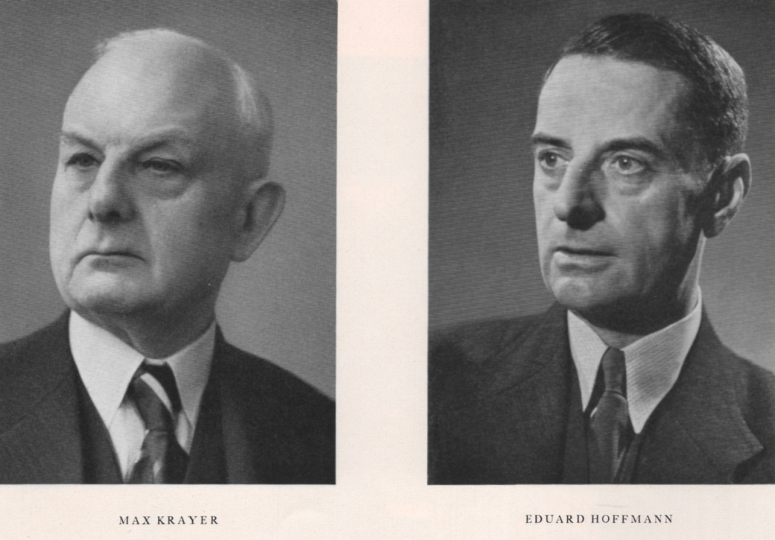Friedrich Bauer did not include Basel typefoundries in his 1914 book, Chronik der deutschen Schriftgießereien. Yet, in its second edition, he expanded the focus to include areas outside of Germany where German was spoken, including Basel. That update was published four years after Gustav Mori’s 1924 history of typefounding in Southern Germany and its neighboring territories.[1] Unlike in his account for Augsburg, Bauer does not seem to have drawn so heavily on Mori’s book when he came to Basel. At least, he did not do so in his summary of Basel’s early typefounders.
Like Augsburg, Basel was an early center of printing. This post is the third entry in my ongoing Friedrich Bauer project. It does not do justice to Basel’s complete typefounding history or the history of the Haas Type Foundry. For instance, Albert Bruckner’s large-format book thoroughly addressed the history of Swiss punchcutters and typefounders in 1943.[2] Unsurprisingly, as the book was published by Haas, 69 pages are devoted to that foundry’s history alone. 1943 was still ten years before Haas’s release of Normal-Grotesk and about a decade and a half before the design and release of Neue Haas-Grotesk and Helvetica, arguably the most famous typeface to have debuted with a Basel foundry.
For more recent summaries of Haas’s history than what you’ll find here, see Gustaf Adolf Wanner’s account from 1979[3] and Brigitte Schuster’s pair of articles in Footnotes.[4] As of this post’s publication, the most recent deep dive into an era of Haas’s history has come from Typotheque, accompanying Nikola Djurek’s revival of Max Miedinger’s lesser-known typefaces.
All text below – until the notes at the bottom of this post – are my translation of Bauer’s Basel entries.
Basel
[Introduction]
Several printers were already active in Basel during the 15th century. Excerpts from documents prove that they also cast type for their own use. Sometimes, they also did so for colleagues who were friends. Here are a few examples.
1472
On 12 March 1472, Bernhard Richel from Ehenweiler, who printed in Basel from 1472 until 1482, confiscated the estate of the [recently deceased] seal engraver Jost Burnhart – but he wanted to deduct “several letters” that the seal engraver made for him [from the two Guilders Burnhart had owned him].[5] So Burnhart had been Richel’s punchcutter. We can conclude that Richel’s son-in-law Nikolas Kessler (1471–1519) continued the foundry because, in 1508, Kessler purchased tin from Martin Leubel in Leipzig for 400 guilders.[6]
1476
In 1476, the letter cutter Hans Frank sued Johann Schilling from Winternheim. The latter was in Basel between 1472 and 1477. The suit was for payment for letters engraved for “Meister Hannß Winterheimer.”
Michael Wenßler, who had worked extensively and successfully in Basel since 1472, got into debt in 1490 and had to sell his entire business to Jakob Steinacher for 253 guilders. That included “matrices, tools, and all other things belonging to a printing house,” as well as a typefoundry.
1477
Johann von Amerbach ([in Basel from] 1477–1513) had a type foundry in his printing house, which cast not only for his own needs but also for other printers. Among others, he supplied the Strasbourg printer Adolf Rusch (died 1489) – known as “the printer of the R-Bizarre”[7] – with the types needed to print a “large Bible” for Anton Koberger in Nuremberg.[8]
1500
Peter Kreyß, a “Geschrifftschneider” [punchcutter], purchased a house on 19 December 1500 from Hans Feigerwinter for 30 guilders.
1519
It is known that the famous Basel printer Johann Froben (born 1460, died 1527),[9] who had his typefaces cast in-house, delivered type to Melchior Lotter. The latter printer, active in Leipzig from 1500 until 1542, established a branch office at Wittenberg in 1519.[10]
1534
Among the first typefounders in Basel, we also find Peter Schöffer the Younger[11] – the son of Gutenberg’s assistant, Peter Schöffer.[12] He had owned a printing press in Mainz since 1513 alongside his older brother Johann Schöffer and also printed in Worms from 1518 to 1529. Then he went to Basel, where he worked under Hieronymus Froben (born 1501, died 1563) as a punchcutter and typefounder.[13] When Johannes Oporinus set up a printing shop with Thomas Platter, Balthasar Ruch (Lasius), and Rupprecht Winter around 1534, Peter Schöffer the Younger cast its types. After that printing house’s dissolution, Platter founded his own, for which Peter Schöffer the Younger again supplied matrices and typefaces.
Thomas Platter (born 17 February 1499, died 26 January 1583) testifies to this in his autobiography, the manuscript of which is in the University Library in Basel,[14] in the following way: “At that time there was a fine artist in printing, Peter Schäffer [sic!], from the family who invented printing in Mainz. He apparently had all kinds of typefaces and punches, [and] he gave me the strikes, he gave them to me for a ring[15] of money, some of which he justified for me and cast for me; some were cast by Master Martin,[16] many from a man named Utz [the] punchcutter,[17] and then I wanted to do something with all those typefaces and presses. So there were several gentlemen who commissioned me to print, including Messers Wattenschne,[18] Frobenius,[19] Episcopius,[20] Hervagius,[21] [and] Michaell Isengrimius.[22]”
In “family news,” an addendum to his biography, Thomas Platter confirms his information about Peter Schöffer.
As in the cases mentioned above, typefounding in Basel was often only carried out as a side activity in printing houses during the following century. Independent typefoundries could only be found in Basel after the middle of the 17th century.
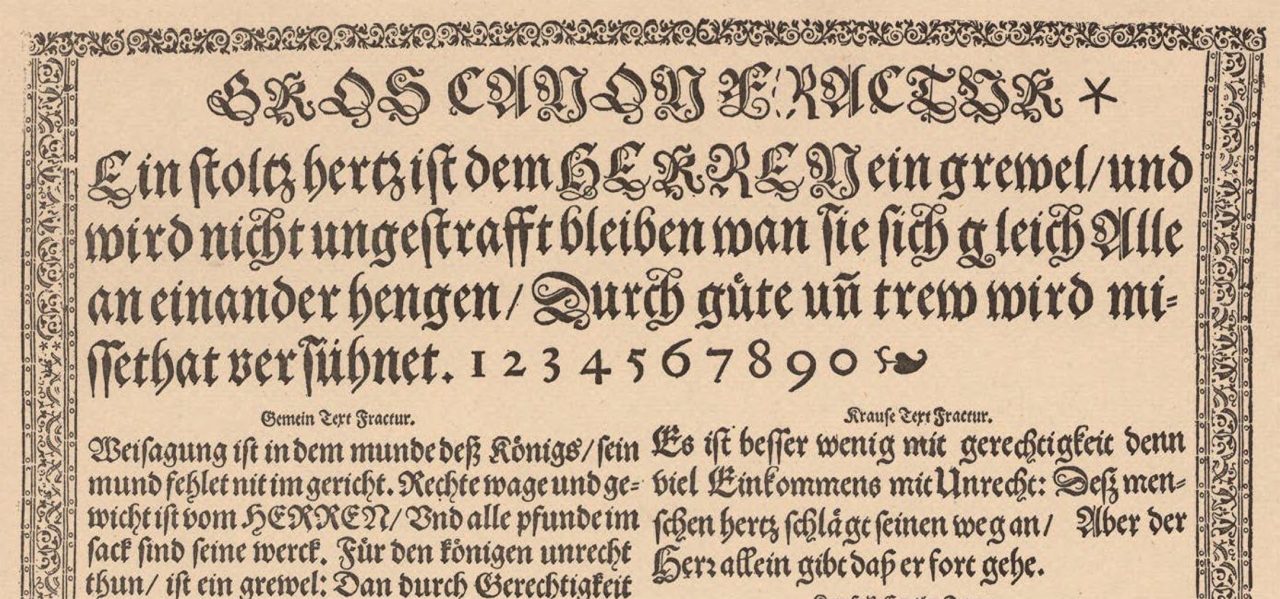
Cropped display of the top portion of Cyriakus Pistorius’s 1673 Fraktur specimen sheet. The image above shows the foundry’s largest three Fraktur sizes, including the Gros Canon Fractur, whose name is given in the top row (in all-caps). According to Albert Bruckner, this is the oldest-known specimen from a Basel typefounder. Image source: Basel University Library, UBH BE I 61.
Pistorius
1673
The typefounder Cyriakus Pistorius,[23] born at Ziegenhain in Upper Hesse, became a citizen of Basel on 13 November 1660.[24] Since, in 1661, he married Jakobea [Decker], daughter of the university printer Georg Decker,[25] it can be assumed that he first worked as a typefounder in Decker’s printing house and later became self-employed.[26] In 1673, Pistorius published a Fraktur type specimen.[27]
Decker acquired his printing house by way of marrying the printer Johann Schröter’s widow in 1633. It was elevated to a council printing house in 1642 and a university printing house in 1644. Typefounding had most likely been practiced there even earlier, for the [Schröter/Decker] printing house’s typefaces were undoubtedly created in the 16th century and had perhaps already used by [Johann] Froben and his descendants.
1704
Cyriakus Pistorius passed the foundry to his son Johann Pistorius (born 7 July 1664), who published a 16-page folio specimen of Fraktur and roman types in 1704.[28] In addition to passages of text, it also included the complete-alphabet showings of 16th and 17th century typefaces. Additional type specimens in poster format followed in 1721.[29]
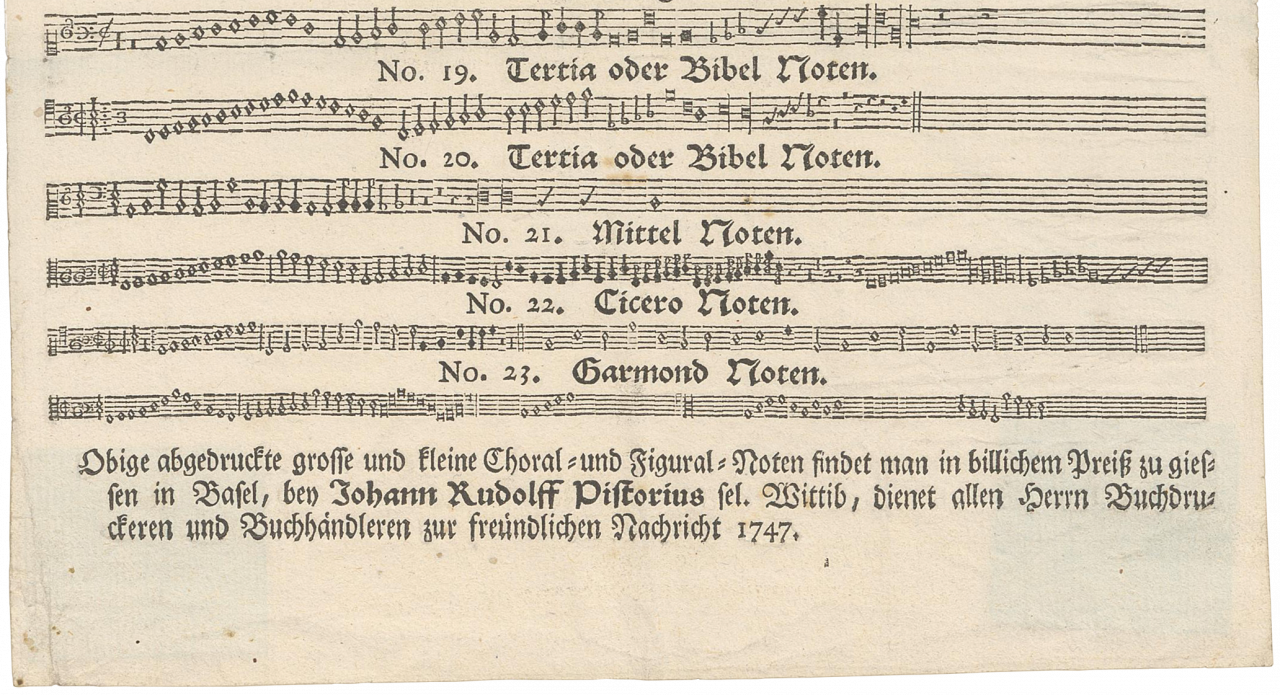
Bottom of the last surviving specimen from the Pistorius foundry in Basel. It was a specimen of musical notation printed in 1747, now kept at the Frankfurt University Library. The specimen sheet was published by Anna Barbara Pistorius, widow of Johann Rudolf Pistorius. Their son kept the foundry running until 1809. You can view a complete digitization here.
1730, 1747, 1809
Johann Pistorius died on 19 April 1730.[30] His son Johann Rudolf Pistorius (born 2 November 1707) continued running the foundry until he died on 11 June 1747. Afterwards, the business was initially taken over by his widow,[31] and then by their son Johann Rudolf II Pistorius, who had been born on 4 August 1733. He died on 12 December 1809 and the foundry subsequently closed down. It was most likely taken over in whole or in part by the Haas typefoundry, which already existed in Basel. The last Pistorius foundry specimen, showing musical notation, had been published in 1747.[32]
Genath – Haas
1654, 1708, 1720
Johan Jakob Genath (born 1582, died 1654) owned a printing house with a typefoundry in Basel.[33] His son Johann Rudolf Genath (born 1638, died 1708) left behind two sons, of whom the younger one, Johann Rudolf II Genath (born September 16, 1679), was a typefounder who took over the foundry.[34] A 1720 specimen sheet, with French text on its footer, displays roman and italic types.[35]
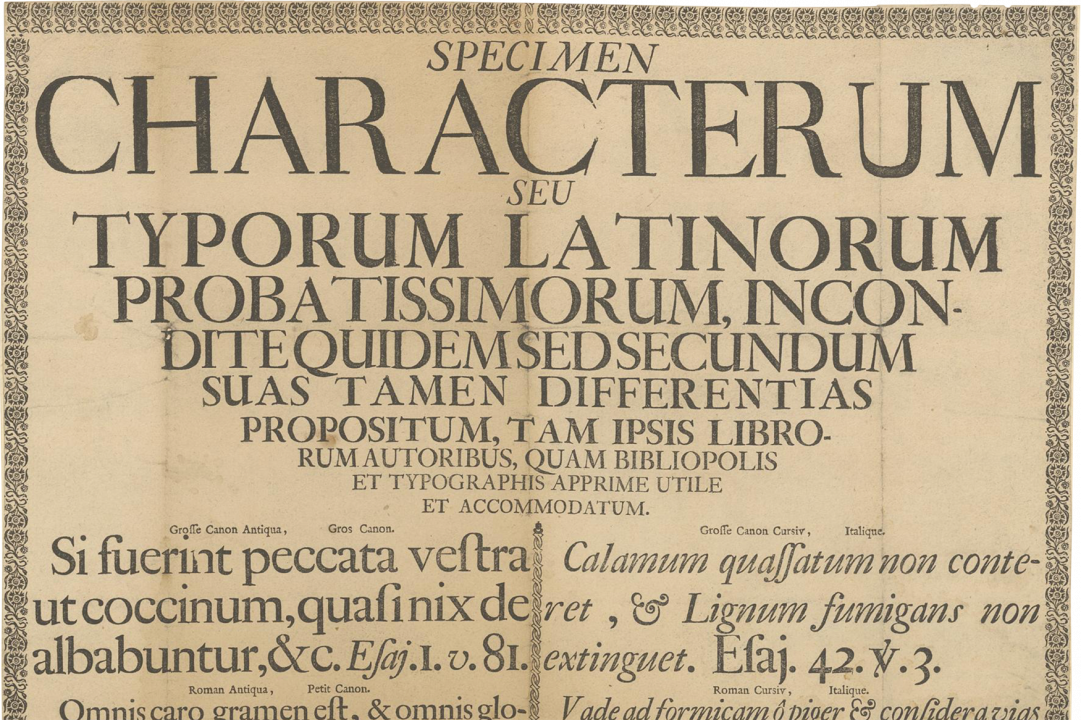
First specimen sheet from the Genath foundry printed after the young Johann Wilhelm Haas arrived in Basel. Some of the types on this 1720 specimen must be from the Pankraz brothers, who had probably trained Haas in punchcutting at Nuremberg, when he was a boy. This specimen is part of the Gustav Mori collection of early type specimens kept at the Frankfurt University Library. Full digitization viewable here.
1737
In a record from the Basel State Archives dated 29 May 1737, Genath – who had no descendants – named the typefounder Johann Wilhelm Haas as his successor. Haas had enhanced the foundry by cutting and casting new types. Genath died on 18 July 1745.
In 1718, Johann Wilhelm Haas came to Genath in Basel from Nuremberg, where he had trained.[36] He was not only a typefounder and punchcutter, but also a seal engraver and machinist.
1745
After Genath died in 1745, Haas took over the foundry. He became a citizen of Basel in 1758 and died in 1764 at the age of 66. His son and successor Wilhelm Haas (born 23 August 1741) had learned the typefounding trade but was also trained in printing and mathematics. He invented a systematic classification for spacing material and leading, which he published in a 1772 memorandum.[37] He also developed improvements to typefounding technology. Those included an “adjustable needle-gauge for testing the depth of strike”[38] for use in matrix justification.[39] His types were well-known for their beauty and were sought after by many.
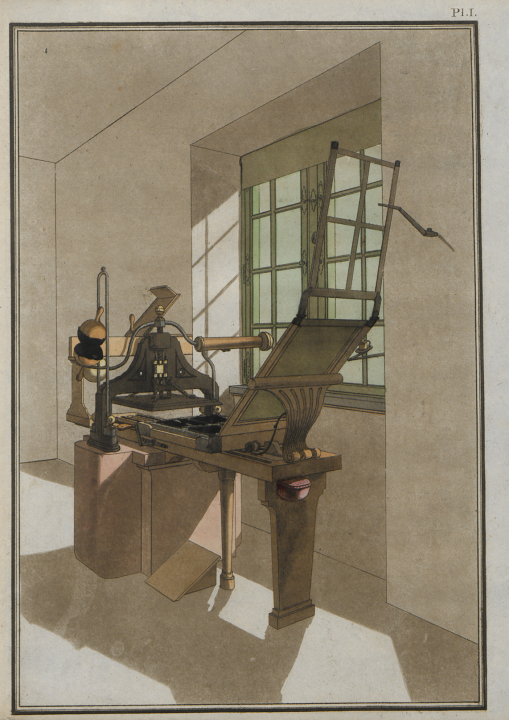
Copperplate illustration of Wilhelm Haas the father’s cast-iron press. From Wilhelm Haas der Vater, Beschreibung und Abrisse einer neuen Buchdruckerpresse (Basel: Gedruckt bey Wilhelm Haas dem Sohne, 1790). Digitized by the Staatsbibliothek zu Berlin – Preußischer Kulturbesitz. Slightly cropped above.
In 1772, Haas invented a new printing press made entirely of iron,[40] whose platen could print a forme with a single pull. However, the Basel printers would not allow Haas to put this new press into use within his workshop because he had not been trained in the art according to their guild’s laws and customs. After long negotiations, Haas was allowed to use the press to print his type specimens, but he could not train apprentices [in printing] or keep journeymen [printers in his employ].[41] In 1776, Haas invented a system for typesetting maps that brought him recognition.[42] Of his type specimens, only an octavo specimen from 1790 showing roman and Fraktur types has been preserved.[43]
Haas also made a name for himself in public service. Among other things, he represented the canton of Basel in the Swiss Grand Council during 1798. In 1799, he was general inspector of the Swiss artillery.
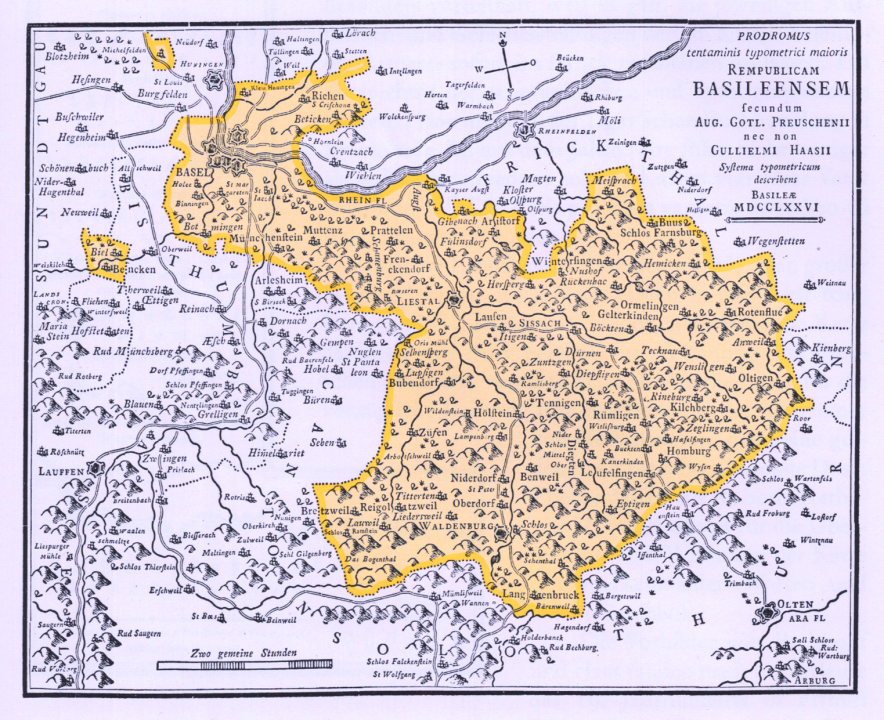
Map of Basel from 1776. Composed and printed typographically by Wilhelm Haas the father, according to a method he developed with Gottlieb Preuschen. From Albert Brucker, Schweizer Stempelschneider und Schriftgiesser (Münchenstein: Haas’sche Schriftgiesserei A.G., 1943), plate 18.
1800
Wilhelm Haas died on 8 June 1800. His successor was Wilhelm Haas the son (born 15 January 1766).[44] He had been in charge of the typefoundry for years, had also learned [the craft of] printing and, had achieved significant results in his own workshop. After continuing to expand on his father’s inventions, he died on 22 May 1838.[45]
1830, 1852
Wilhelm Haas the son handed over the business to his sons [Georg] Wilhelm and [Karl] Eduard Haas in 1830,[46] under whom the foundry quickly fell into disrepair. Shortly before they died in 1852,[47] they sold 500 pounds of their matrices as scrap copper and thereby reduced the stock of good old typefaces to just a few remnants.
1857
Two remaining workers, the typecaster Jakob Haas – no relation to the previous owners but employed in the foundry since 1795 – and G. Münch took over the business in 1852.[48] In 1857, they sold it to Otto Stuckert, a native of Lörrach,[49] for 5,173 old Swiss francs. Stuckert tried to get the foundry back on track.[50] In 1863–1864, he published specimens in the form of a magazine called the Magasin typographique.[51] This was outfitted very well. However, his primary focus was on mechanical engineering, for which he employed about 120 workers. [The foundry] fell into decline again in 1866.[52]
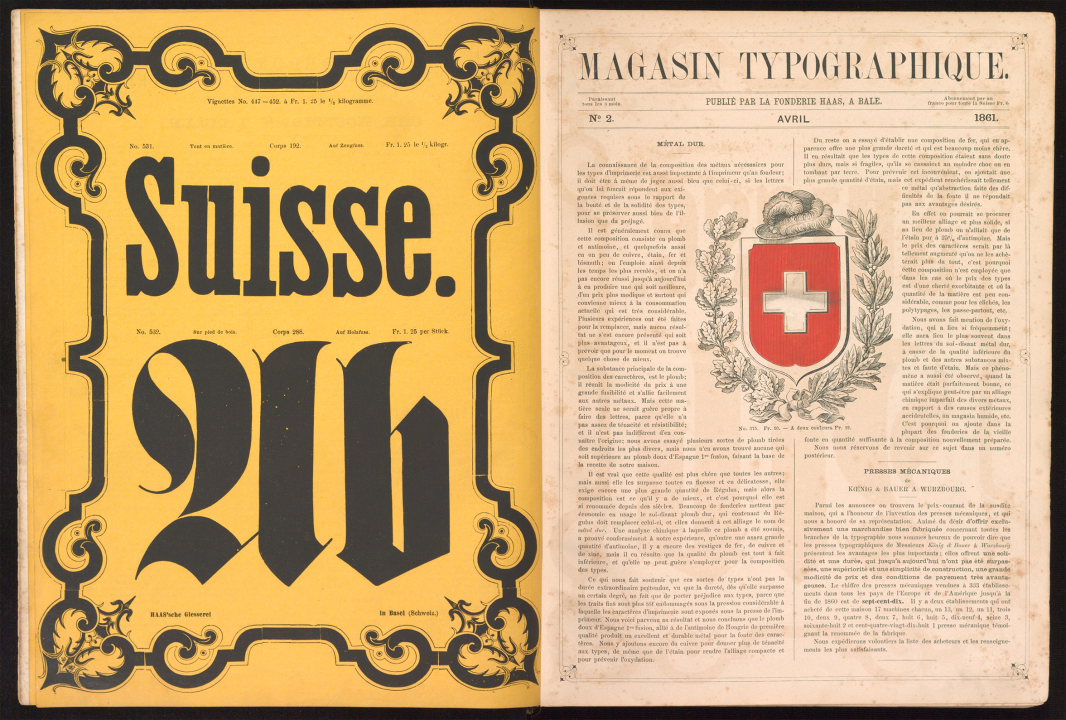
Digital collage of pages from the second issue of Haas’s newsletter, Magasin typographique (1861). Most of the text in the newsletter was printed in French. In the Basel University Library’s volume of Haas foundry specimen sheets with the shelf number UBH AN I 525, the two pages seen above are indeed bound across from each other. In the digital version of that volume, you can find them in pages 18 and 19 of the PDF.
1866
From 1866 to 1895, the Basler Handelsbank owned the Haas foundry. Then, it was purchased by Fernand Vicarino.
1904
Since 1904, Max Krayer has been the Haas Type Foundry’s owner.[53] He moved it to Münchenstein near Basel.[54] Under his management, it has once again reached a respectable height.[55]
1927
The Haas Type Foundry was incorporated in 1927. At the same, it entered into a community of interests with the typefoundries H. Berthold AG in Berlin and D. Stempel AG in Frankfurt am Main.[56]
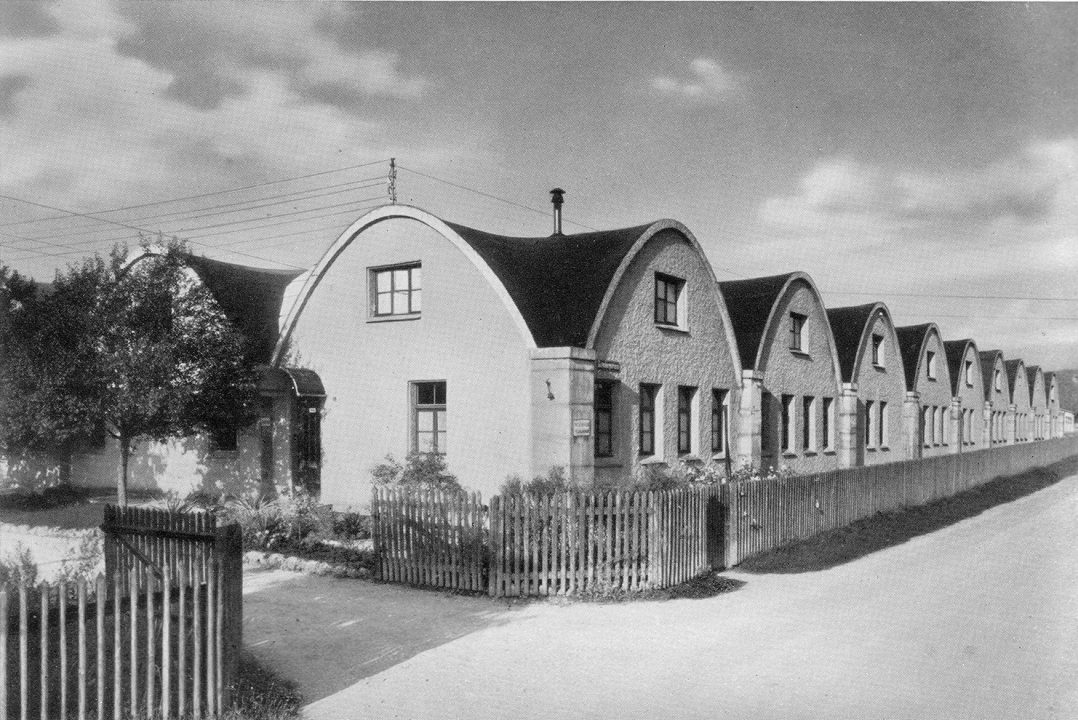
Undated photograph of the facilities Haas moved into in 1921. They reportedly cost more than twice as much to build as planned. With a system of vaulted ceilings, the architecture does not have the same “urban factory building” look Haas’s counterparts in Germany constructed. Image courtesy of Hans Reichardt.
Bär – Jünemann
1858
The typefoundry Bär from Zurich built a small foundry in Basel in 1858, about which nothing else is known.
1866
A typecaster and machinist from Berlin named August H. Jünemann, who had worked at the Haas Type Found foundry from 1858 until 1865, operated a workshop constructing typecasting machines in Basel-County in 1866.
Notes
The portraits of Max Krayer and Eduard Hoffmann at the top of this post are from Albert Brucker, Schweizer Stempelschneider und Schriftgiesser (Münchenstein: Haas’sche Schriftgiesserei A.G., 1943), plate 27. Other images’ sources have been explained in their captions.
- Gustav Mori, Das Schriftgiesser-Gewerbe in Süddeutschland und den angrenzenden Ländern (Stuttgart: Bauer & Co. and Felix Krais, 1924).
- Albert Brucker, Schweizer Stempelschneider und Schriftgiesser. Geschichte des Stempelschnittes und Schriftgusses in Basel und der übrigen Schweiz von ihren Anfängen bis zur Gegenwart (Münchenstein: Haas’sche Schriftgiesserei A.G., 1943).
- Gustaf Adolf Wanner, «400 Jahre Haas’sche Schriftgießerei» in Gutenberg-Jahrbuch 54 (Mainz: Gutenberg-Gesellschaft, 1979), pp. I–XV (between pp. 324–325).
- Brigitte Schuster, “The Haas Typefoundry Ltd. in an international Environment: Changes and Developments in its organisation and operation” parts one and two in Mathieu Christe (ed.), Footnotes A (2016), pp. 38–47 and Footnotes B (2017), pp. 50–56.
- Bruckner pp. 16–17 and 36 (see note 2 above).
- Foundry type is cast from an alloy of lead, antimony, and tin. When existing type is melted down to be cast afresh, some of the alloy’s tin is burnt off and must be replaced; see Claire Bolton, The fifteenth-century printing practices of Johann Zainer, Ulm, 1473–1478 (Oxford: Oxford Bibliographical Society and London: Printing Historical Society, 2016), p. 16, note 69.
- One of Rusch’s types did indeed have an uppercase R that was bizarre. The face, Type 2:100G, has been redrawn as an OpenSource font, as part of the ANRT Gotico-Antiqua project.
- Christie’s calls this the “Koberger Bible.” It is a Latin Bible; the first to include medieval commentary. As Bauer wrote, Rusch in Strasbourg printed it for Koberger, the book’s publisher in Nuremberg. However, other sources use the “Koberger Bible” descriptor for a German-language Bible Koberger printed in 1483
- For general biographical details on Johann Froben, see Arnold Pfister, »Froben, Johann« in: Neue Deutsche Biographie 5 (1961), pp. 638–640 [here is the online version].
- For more on Melchior Lotter the elder, see Hans Lülfing, »Lotter, Melchior der Ältere« in: Neue Deutsche Biographie 15 (1987), pp.&snbsp;246–247 [here is the online version] or, in English, see Andrew Pettegree, Brand Luther: 1517, Printing, and the Making of the Reformation (New York: Penguin Press, 2015), pp. 110–114.
- In his seminal book, A view of early typography up to about 1600. 2nd edition (London: Hyphen Press, 2002), Harry Carter seemed very impressed with Peter Schöffer the Younger, ascribing the introduction of “the modern era typefounding in which very few punchcutters supply the total demand” to him. [p. 109].
- Peter Schöffer the Elder, usually referred to as just Peter Schöffer or Peter Schöffer of Gernsheim, was born at Gernsheim in 1425. Gernsheim is about a day’s walk south from Mainz. Schöffer ran Gutenberg’s workshop after Johannes Fust seized it in 1455 and quickly became one of the first (and maybe best of) the printer-publishers active in Europe. He died at Mainz in 1503.
- Carter p. 113 (note 11 above) questioned this claim, writing that “I do not know why Friedrich Bauer, the historian of German typefounding, affirmed that Schöffer acted as punchcutter and typefounder to Hieronymous Froben and Episcopius after leaving Worms in 1529, because he does not cite the source of his information.”
- The Basel University Library has two entries for Thomas Platter’s 1572 autobiographical manuscript. Under Lebensbeschreibung, 1572, one entry is for the main manuscript. The other is for his addenda.
- Florian Hardwig helped with this paragraph’s translation, for which I am grateful. When it comes to the “ring of money” that Platter paid to Schöffer the Younger, Florian replied, “I don’t know whether a ring is a specific unit or just ‘a lot.’” I’ve found several historical mentions of »ein ring Geld« on Google Books, so perhaps it is just an expression. Anyone know for sure?
- Master Martin was the typefounder Martin Hosch; see Bruckner pp. 28, 42, and 44–45 (note 2 above).
- Utz the punchcutter was Goruch Köpfle; see Bruckner pp. 28, 42, and 45 (note 2 above).
- This must be the printer Johannes Wattenschne.
- This must be Johann Froben’s son Hieronymus Froben, also a printer.
- Platter was name-dropping yet another Basel printer, Nicolaus Episcopius.
- This must be the printer Johann Herwagen.
- As for most of the other printers, Platter used the Latin spelling of Michael Isengrin’s last name.
- Bauer’s entry for the Pistorius typefoundry only offers an abbreviated account of its activities. The business was active in Basel for more than a century, run by at least four generations of the family. In his chronicle, Bauer devoted about a page to it. Bruckner’s history, on the other hand, includes more than 14 pages of information; see Bruckner pp. 51–65 (note 2 above).
- Mori p. 15 (see note 1 above) supposes that Pistorius had most likely worked at the Luther typefoundry on Frankfurt am Main,
- Georg Decker (1596–1661) was born in Eisfeld, then in Electoral Saxony. Today, it is part of Thuringia. Decker likely trained as a printer in a city near Eisfeld before gradually moving to the southeast. He worked in Tübingen before arriving in Basel, where he married Margarete Zäsinger in 1635. She was the widow of the Basel printer Johannes Schröter. In the eighteenth and nineteenth centuries, descendants of Decker and Zäsinger would run a successful printing house and typefoundry in Berlin. This will be addressed later on in this series of Friedrich Bauer project posts.
- Bruckner p. 52 note 8 (note 2 above) counters that no source proves that Pistorius worked for Decker prior to his marriage.
- A digital copy of this specimen is provided by the Mori Collection at the Frankfurt University Library. The Basel University Library has shared one, too. Bruckner p. 53 (see note 2 above) describes this as the oldest-known specimen from a Basel typefounder.
- The Gutenberg Museum in Mainz has part of Gustav Mori’s collection of early type specimens, which includes the 16-page Pistorius specimen described here. The specimen has not been digitized. According to Friedrich Bauer’s son, Konrad F. Bauer, this specimen includes a roman titling face from the early sixteenth century created for the transcription of Ancient Roman inscriptions; see Konrad F. Bauer, »Antiqua und Antike« in Gutenberg-Jahrbuch 33 (Mainz: Gutenberg-Gesellschaft, 1958), pp. 16–19, here p. 16.
- The Mori collection at the Frankfurt University library includes three, which is probably what Bauer knew and was referring to, Those are a specimen of roman and italic types, another specimen of romans and italics, and a specimen of Fraktur, Schwabacher, Kurrent types, and calendar symbols.
- Brucker p. 62 (note 2 above) writes that Johann Pistorius retired in 1727. His son Johann Rudolf Pistorius published one specimen of six Fraktur titling faces in 1729, which Bauer does not mention. The Frankfurt University Library had digitized that specimen.
- Anna Barbara Pistorius née Vest; see Bruckner pp. 62–63 (note 2 above).
- The Frankfurt University Library has digitized this specimen. It was published by Johann Rudolf Pistorius’s widow Anna Barbara.
- Genath was not born into a printing family. He entered the profession after his studies at the University in Basel; see Bruckner p. 67 (note 2 above).
- Bruckner p. 75 (note 2 above) seems to indicate that the typefoundry was split off from the Genath family’s printing house in 1702.
- The Frankfurt University Library has digitized this specimen. François Rappo consulted it to design Genath, a baroque roman and italic family of digital fonts distributed by Optimo. Optimo’s page for the family states that the “1720 specimen [included] Johann Wilhelm Haas’ first design for the Genath Foundry,” which may be true. However, as the following note mentions, many faces on Genath’s 1720 specimen are probably cast from duplicate matrices for types from Haas’s likely mentor(s).
- Bruckner p. 79–80 (note 2 above) finds it likely that Johann Wilhelm Haas learned his craft from the punchcutters Johann and Pankraz Lobinger. On p. 80, Bruckner continues, writing that Haas brought types from them to Haas, noting that, in the 1720 Genath specimen, “it is striking that the types shown correspond without exception to those on the broadsheet specimen from the Academic Printing House in Prague from 1678. Those come with complete certainty from Pankraz Lobinger’s workshop in Salzburg.” The Prague specimen of roman and italic types from 1678 that Bruckner mentioned has been digitized by the Frankfurt University Library. The library’s entry for the items also notes that it bears types from the Luther foundry in Frankfurt.
- Wilhelm Haas, Erklärung einer neu-erfundenen und gemeinnützlicheren Einrichtung der Stück-Linien und Zwischenspäne mit den dazu gehörigen Tabellen nebst einer Anmerkung über die gegossenen Stege (Basel: Wilhelm Haas, 1772). WorldCat lists three copies of this memorandum. One is at the Basel University Library. Another is at the Newberry Library in Chicago. The third is in a Swedish library. Bruckner p. 90 (note 2 above) states that Haas printed this on the new cast-iron printing press he had invented.
- Bauer’s original text calls the gauge eine Justiernadel für das Justieren der Matrizen. In the notes to their edition of Moxon, Herbert Davis and Harry Carter describe it as an “adjustable needle-gauge for texting the depth of strike.” See Joseph Moxon, Mechanick Exercises on the Whole Art of Printing. Edited by Herbert Davis and Harry Carter. Second edition. (Oxford University Press, 1962) p. 19. In the earlier notes on his translation of Fournier’s Manuel typographique, Carter provided much more information: “Wilhelm Haas (born 1741), one of the more technically-minded of the punchcutters of the second half of the 18th century, invented an adjustable punchcutters’ gauge which he claimed was capable of a measurement of 1/1100 of the pouch du pied de roi. It is described and illustrated in the ‘Caractères d’imprimerie’ in De Felice’s Encyclopédie, ou dictionnaire universel raisonné des connoissances humaines, vol. 7 (Yverdon, 1771), and plate 1 in section 10, ‘Fonder des caractères’ (Plances, vol. 4, 1777); in his portrait (reproduced in A. Bruckner, Schweizer Stempelschneider und Schriftgiesser, Basel, [1943]) Hass is shown holding this instrument.” See Pierre-Simon Fournier le jeune, The Manuel Typographique of Pierre-Simon Fournier le jeune. Together with Fournier on Typefounding, an English Translation of the Text by Harry Carter in Facsimile. With an Introduction and Notes by James Mosley (Technische Hochschule Darmstadt, 1995) vol. 3, pp. *340–*341.
- For photographs of an adjustable needle-gauge, see David M. MacMillan’s site; scroll down to “13.1. Screw/Needle Depth Gauge.”
- Wilhelm Haas’s cast-iron press predated the Stanhope press’s invention by several decades. Nevertheless, James Moran described the Stanhope press as an improvement over Haas’s press, not a counterfeit; see James Moran, Printing Presses: History and Development from the fifteenth century to modern times (London: Faber and Faber, 1973) p. 50.
- For similar reasons, Pierre-Simon Fournier le jeune had also been barred from printing, before he successfully petitioned for an exception; see Fournier pp. xxvi–xxix (note 38 above). See also Bruckner pp. 91–93 (note 2 above).
- Around the same time, Johann Gottlob Immanuel Breitkopf in Leipzig developed his own method of composing and printing maps typographically; c.f. Bruckner pp. 95–98 (note 2 above).
- The Houghton Library at Harvard University has digitized this specimen.
- In German, the two men named Wilhelm Haas are differentiated by the terms “the father” and the “the son,” e.g., Wilhelm Haas der Vater und Wilhelm Haas der Sohn. An edition of diary entries from the younger Haas was published in 1997, see Markus Kutter (ed.), Ein Genie der Typographie. Wilhelm Haas, 1766–1838. Sein Tagebuch (Basel: Basler Papiermühle, 1997).
- Bauer’s account of Wilhelm Haas the son’s life and the Haas foundry’s tenure under his direction is incredibly brief. While Mori pp. 21–22 (note 1 above) does not provide much more detail, Bruckner’s chapter on him runs for 25 pages; see Bruckner pp. 104–129 (note 2 above).
- Like his father before him, Wilhelm Haas the son had transitioned into public service.
- Georg Wilhelm Haas and Karl Eduard Haas both died during the same week in 1853. It was their mother who died in 1852. Georg Wilhelm Haas had been born in 1792, his brother Karl Eduard in 1801. Neither married or had children to inherit the foundry from them; see Bruckner p. 129 (note 2 above).
- Johann Jakob Haas-Baumann (1784–1868) and Karl Friedrich Mönch Winkler, also a typecaster; see Bruckner p. 130 (note 2 above).
- Lörrach is just across the German border from Switzerland. It is situated directly above Reihen, which itself is to the right of Kleinbasel on the right-hand side of the Rhine.
- Bruckner p. 131 (note 2 above) describes how the foundry replenished its offerings: it purchased strikes from providers in Germany, including Johann Christian Bauer, F. A. Brockhaus, the Dresler typefoundry, A. Gerlach, Eduard Haenel, Gustav Schelter, Ferdinand Schumacher, and Trowitzsch & Sohn. About a year ago, I had the Basel University Library digitize an 1860 volume of Haas specimen sheets. Judging by that volume, Haas must have already had a great deal of recent typefaces by then.
- The Magasin typographique’s first issue was published in January 1861. Three more issues followed that year. Issue five would not appear until January 1864. The last issue that I have found, number nine, was published in January 1865. These nine issues are bound into a the beginning of another large volume of Haas foundry specimen sheets kept at the Basel University Library that I had digitized a few years ago. The library estimates that the volume was bound in 1866 or 1867. In the Deutsches Museum’s digitization of the 1864 issues from Journal für Buchdruckerkunst, a German printing journal, some issues of Haas’s Magasin typographique can also be found.
- According to Bruckner’s account [p. 132–133 (note 2 above)], it would seem that Stuckert’s other ventures must have been the cause. Looking at Haas specimens and at issues of Magasin typographiqe, one could be forgiven for being unaware of Haas’s economic woes.
- Max Krayer was the uncle of Eduard Hoffmann, of Helvetica fame. Hoffmann joined the typefoundry on the business side in 1917 and became its co-director in 1937; see Bruckner p. 135 (note 2 above). c.f. Brigitte Schuster, “The Haas Typefoundry Ltd. in an International Environment; Changes and Developments in its Organisation and Operation” at lapolice.ch. Hoffmann’s son Alfred was also a Haas director. He was featured in Gary Hustwit’s Helvetica documentary and only recently passed away in 2022.
- The foundry moved to newly-built factory buildings in Münchenstein in 1921. The buildings still stand. Today, they house a school.
- Bruckner’s book does not mention the punchcutter Edmund Thiel, who was with the company from at least 1924 onward; see Die Drucktype: Rückblick, Gegenwart, Ausblick (Münchenstein: Haas’sche Gießerei, 1980) pp. 29–31.
- In 1927, Berthold and Stempel each purchased 45% ownership in the Haas Type Foundry; see Schuster (note 53 above).
